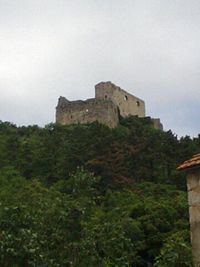Open tothe public Yes | Materials Limestone | |
 | ||
Type Stronghold, Castle, Fortress Condition Ruined, slightly renovated Built 3rd century BC ?, expended in 1406 Built by small stronghold by Dalmataeexpended by Hrvoje Vukčić Similar Klenovnik Castle, Bajnski Dvori Castle, Cippico Castle, Ostrovica Fortress, Maruševec Castle | ||
Prozor Fortress (Croatian: Tvrđava Prozor or Gradina) is a medieval fortress situated in the continental part of Split-Dalmatia County, in inland Dalmatia, just above the town of Vrlika in Croatia. From its origin as a small stronghold built by the ancient Illyrian tribe Dalmatae, it developed into a fortress in the 15th century, during the reign of the Croatian and Bosnian feudal lord Hrvoje Vukčić Hrvatinić.
Contents
Location
Prozor Fortress sits prominently above the town of Vrlika. It was chain link of near by forts like fort Glavaš - Dinarić and Potravnik. The closest large towns are Sinj, Knin, and Drniš. Prozor Fortress has an equally spectacular view of the Peruća Lake (Perućko jezero) and mountains Dinara and Kamešnica to the east and mountain Svilaja to the southwest. Prozor Fortress is made of stone like other fortresses in Dalmatia. It is partially restored, and entrance is free of charge. The way up to Prozor Fortress starts at the Roman Catholic parish church in Vrlika. It takes a 1.5-kilometre (0.9 mi) car ride towards small village of Maovice, followed by a 25-minute walk along a dirt trail.
History
Prior to the arrival of the South Slavs, the Dalmatae are said to have lived in the region. The known history of Prozor Fortress begins parallel with the history of Vrlika in the 7th century, when the Croats moved there and formed a village on the spring of the river Cetina, in a field below the mountain Dinara. In the 9th century probably during the time of Duke Branimir of Littoral Croatian Duchy, the old Croatian Catholic St. Saviour (Croatian: Crkva Sv. Spasa) was built near Vrlika, then called Vrh Rike.
In 1406, king Ladislaus of Naples gifted Prozor Fortress, at that time Castrum Werhlychky, as a center of Vrlička župa to the Hrvoje Vukčić. Hrvoje Vukčić Hrvatinić was a Ban of Croatia, Grand Duke of Bosnia and a Herzog of Split. He was the most prominent member of House of Hrvatinić and one of the most important three feudal lords of medieval Bosnia at the time. At the beginning of the 15th century, Hrvoje Vukčić fortified and strengthen the Prozor Fortress over the Vrlika valley to defend inhabitants from the invasion by the Ottoman Empire. After 1416, Hrvoje Vukčić die, but his son Balša Hercegović don't have power to hold Prozor Fortress, which then belongs to Ivaniš Nelipić, and later to Ivan Frankopan.
In 1421, king Sigismund donated Vrlika with the Prozor Fortress to Mihača Nikolin Vitturi, but Ivaniš Nelipić refused to handover the fortress. When wealthy Prince Ivaniš Nelipić, the last male member of Frankopan's illustrious clan, died in 1434, the problem of inheritance became acute. According to his will, his only daughter, Princess Catherine or Margarita Nelipić, was to inherit all of his extensive possessions from the Velebit ranges to Cetina river. Her patrimony was argued and eventually shared by Frankopan. In spite of the legality of this bequest, and his consent to the marriage upon request of the late Ivaniš Nelipić, king Sigismund denounced the testament and demanded that Frankopan turn over to him the legacy of his wife's inheritance. When Frankopan refused to obey, Sigismund proclaimed him a rebel and deprived him of all honors and possessions. After that the fortress was lost to Venetian noble Mihača (Mikac) Nikolin Vitturi from Trogir, who was a commissioner of king Sigismund.
The Turks invaded the fortress in 1522, and held it until 1688. After the fortress was taken, the Turks, disregarding the conditions of its surrender, massacred all within it. Of all the lords of the Prozor Fortress, folk tales best remember the bloody Suli-ma Muli-Hodzic. After the Turks, the fortress belonged to the Republic of Venice, then to the Austrian Empire, when it lost its main strategic importance. From 1805 to 1813, it was under French rule, and from 1813 to 1918 it again under the Austrian rule, as was all Croatia.
Architecture
Prozor Fortress was built on isolated rock, deatached from the craggy clif on the end of mountain Svilaja range of hills. The remains of the Prozor Fortress are the ruins of a spacious residential building, a water tank, stone walls and a chapel. The Prozor Fortress was expended while it was owned by Hrvoje Vukčić Hrvatinić at the end of 14th and early 15th centuries from the small stronghold built by the Illyrian tribe of Dalmatae. In Turkish times the mahala, or the housing area of Vrlika fortress, developed around it. Prozor Fortress is dominated by the tall keep or donjon, around which is an open court with houses and a chapel. The courtyard is defended by the lower ramparts and a round tower. A drawbridge once gave access to the keep. Today's condition of Prozor Fortress is poorly, as the fortress is ruined, although slightly renovated.
